
The End of Giant Horseshoe Crab
When giant dragonflies dominated the sky, giant centipedes roamed the forest floor, and hexapods and myriapods enjoyed the conveniences brought by their huge bodies for the first time, another group of giant arthropods with much older qualifications had already experienced the vicissitudes of life and deeply understood what “bigness has its own difficulties”. Since replacing the Anomalocaris in the Ordovician period and ascending to the top of the food chain (see Chapter 82: The Iron Scorpion 1: The Claw Battle), the Eurycoma has fought fiercely with the giant nautilus and survived the mass extinction at the end of the Ordovician period. Let’s know about Giant Horseshoe Crab
After that, it quickly evolved into a wide variety of species and reached the limit of the size of arthropods in the early Devonian period (see Chapter 110: The Iron Scorpion 4: The Peak of Arthropods). Their claws and tail stings were once the most deadly weapons on earth. Their segmented exoskeletons are both indestructible armor and can move flexibly; they can swim across the blue sea, cross rivers, live in forests and swamps, and dive into mud and sand, and they are invincible.
However, the sudden rise of jawed fish changed everything. Whether in size, strength, speed, flexibility or attack power, vertebrates have surpassed their old arthropod rivals in all aspects. The huge size of the eurypteran horseshoe crab began to show various disadvantages: they were easily targeted by giant placoderms, and their clumsy bodies and heavy armor were vulnerable to the jaws of their opponents, which would only slow down their escape speed. Even if they escaped from their natural enemies, it was difficult for them to catch enough food, because their former main prey: slow-moving trilobites and jawless armored fish , had been hunted to extinction.
Horseshoe crabs
Most eurypteran horseshoe crabs did not even survive the extinction event at the end of the Devonian period and left the stage in disgrace. After entering the Carboniferous period, sharks, holocephalans and lobe-finned fish quickly occupied the ecological niches vacated by placoderms, leaving no chance for the surviving eurypteran horseshoe crabs to revive. So, like the trilobites, the old predecessors of arthropods , the eurypteran horseshoe crabs also embarked on a long road of decline.
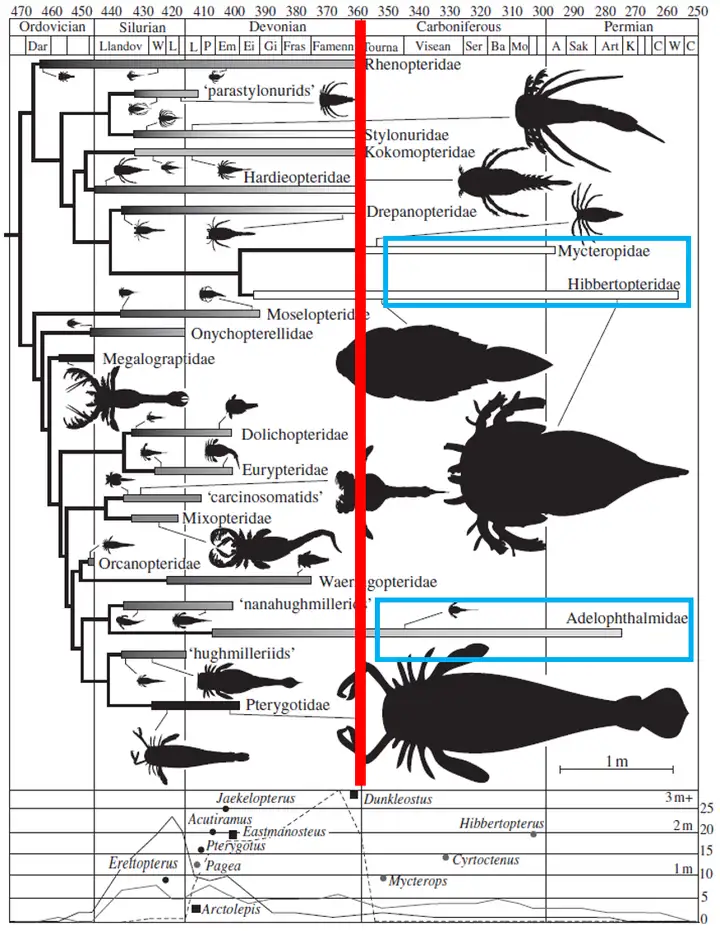
The Eurycoma family was once extremely prosperous, with extremely high numbers and diversity. However, only a few species of Eurycoma ( Adelophthalmidae, Mycteropidae, and Hibbertopteridae, marked with blue boxes) survived the end-Devonian extinction (red vertical line). Image source: [1].
The last giant horseshoe crabs lived at the bottom of freshwater swamps and submerged rainforests, where they could avoid attacks from large carnivorous fish. In the slippery and slimy shallow mud, early tetrapods were as slow and clumsy as they were, and had no advantage. They had lost the oceans and rivers, and were unable to move to land, so the mud between water and land became their last home.
For example, the giant Hibbertopterus hibernicus in the late Carboniferous period was about 1.6 meters long. This type of giant horseshoe crab was no longer a ferocious predator. They had hard bristles on their feet, which they used to dig and sift sediments. They plowed the mud again and again like small tractors, searching for the remains of plants and animals, worms and mollusks. If they could pick up a rotten corpse, it would be a delicious meal.
Hibbert’s horseshoe crab
A restored image of Hibbert’s horseshoe crab. The shadow of the former arthropod overlord can still be seen on its body, but the huge claws have disappeared, just like the descendant of a majestic armored warrior who has fallen into the muddy scavenger. See the watermark for the source of the image.
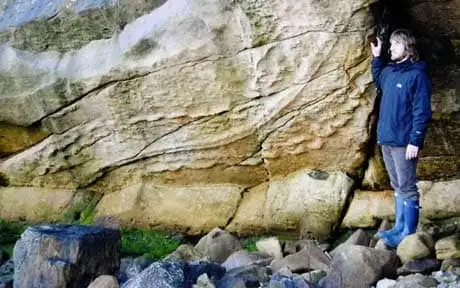
Hibbert’s horseshoe crab footprint fossil. Compared with the person on the right, you can feel how huge this animal is. Image source: Internet.
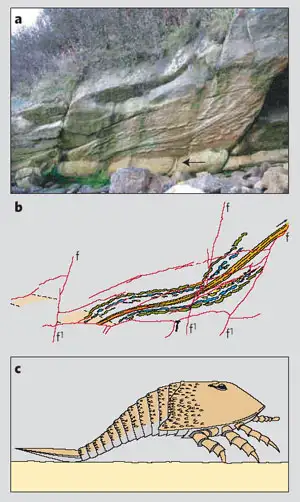
This footprint fossil is from 330 million years ago. Based on its shape, we can infer the body size, limb structure and crawling method of Hibbert’s horseshoe crab. Image source: [2].
Another type of Late Carboniferous horseshoe crab was of medium size and was once thought to be a giant spider (see Chapter 110
Iron Scorpion 4: Peak of Arthropods). It was later named Megarachne . The spider crabs were about 50 cm long and had long, thin appendages. Their lifestyle may have been similar to that of Hibbertopteridae. Mycteropidae and Hibbertopteridae belong to the superfamily Hibbertopteroidea. Little is known about this type of horseshoe crab.

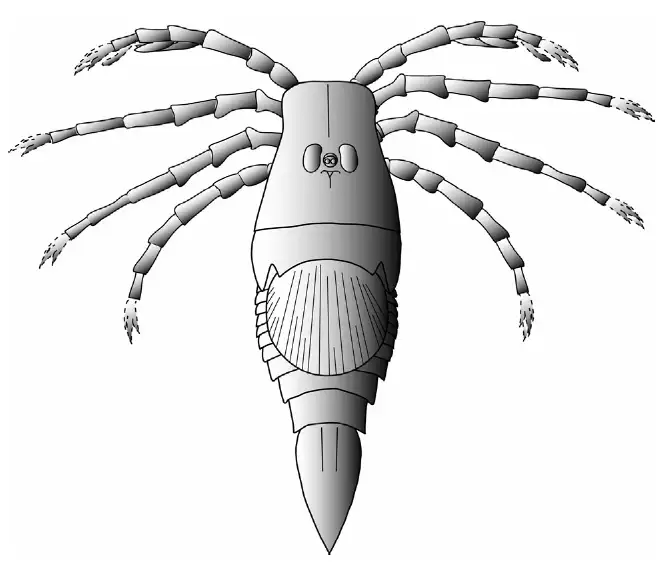
Small group of horseshoe crabs
There was also a small group of horseshoe crabs in the Carboniferous: the Adelophthalmidae. Together with crustaceans, they cleaned up the remains of plants and animals in shallow seas. The Adelophthalmidae appeared in the early Devonian and lasted until the middle Permian . They were considered long-lived in the family of horseshoe crabs.

Fossil and reconstruction of the Adelman horseshoe crab ( Adelophthalmus granosus ) from the Late Carboniferous . This animal was only about 15 cm long, about the size of a crayfish.
The giant horseshoe crabs died out in the Carboniferous, and a few small species survived until the end of the Permian, and then disappeared from the history of the earth along with countless other creatures. However, another branch of the limbs, the Xiphosura, is the familiar horseshoe crabs that look like ladles, and has been developing steadily. Their prosperity lasted until another mass extinction at the end of the Mesozoic era, and a few species have successfully survived to the modern era (see Chapter 83: Iron Scorpion 2: Millions of Horizontal Grinding).
Morphology
This type of horseshoe crab has not changed much in its morphology over its long evolutionary history. However, there have been several interesting revisions, such as the two below.
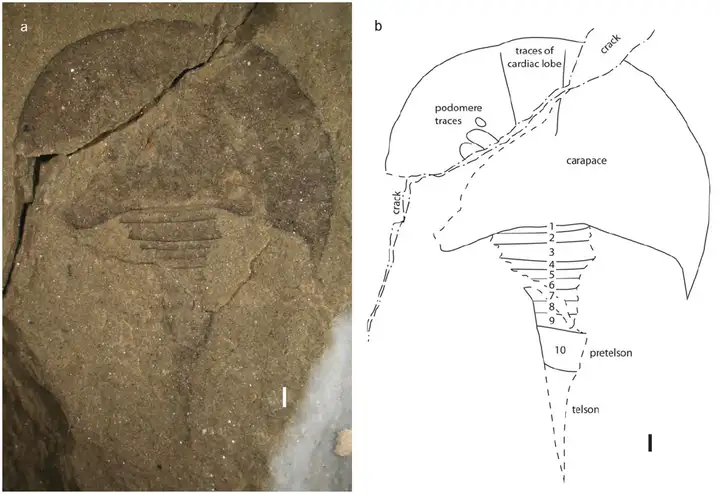
A fossil of a horseshoe crab from the Devonian period found in Yunnan. Its plastron is not fused into one piece. Its elongated abdomen and tail sword drag behind its huge cephalothorax, giving it a very strange shape. The discoverer named it: Lunar horseshoe crab ( Kasibelinurus yueya ).

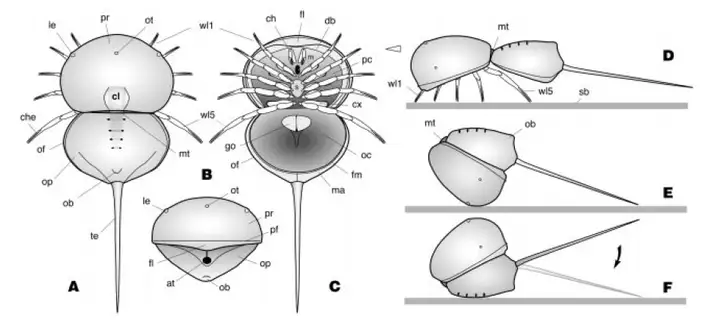
Freshwater horseshoe crab
This small freshwater horseshoe crab ( Alanops magnificus ) that lived in the late Carboniferous period was only the size of a thumbnail. Its cephalothorax and plastron were very similar in size and shape, connected by flexible joints. When in danger, it folded its chest and abdomen into a small ball with thorns to protect its appendages and soft internal organs. Its size and self-defense method were very similar to those of the long-extinct trilobites
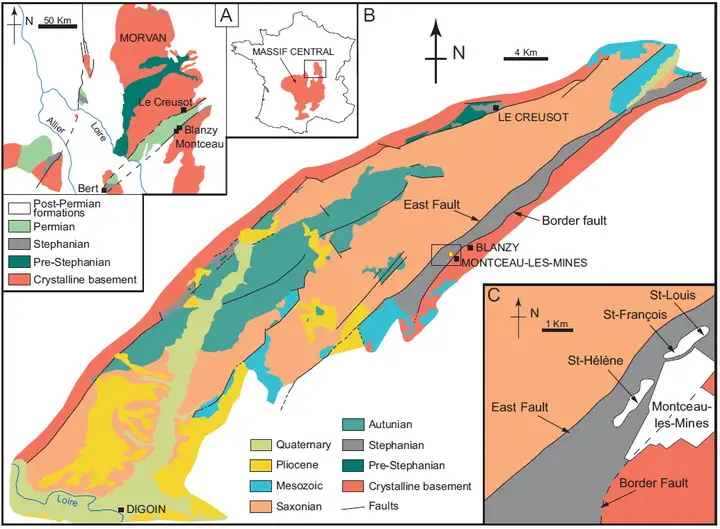
Alanops magnificus was discovered in the Montceau-les-Mines
Lagerstätte in France. This is also a fossil site from the Late Carboniferous. Where more than 120,000 exquisite fossil specimens have been unearthed. Most of which are well preserved, including internal structures and soft tissues. In the following chapters, many organisms found here will be cited. The geographical location of the Montceau-les-Mines Lagerstätte. Image source: [7].
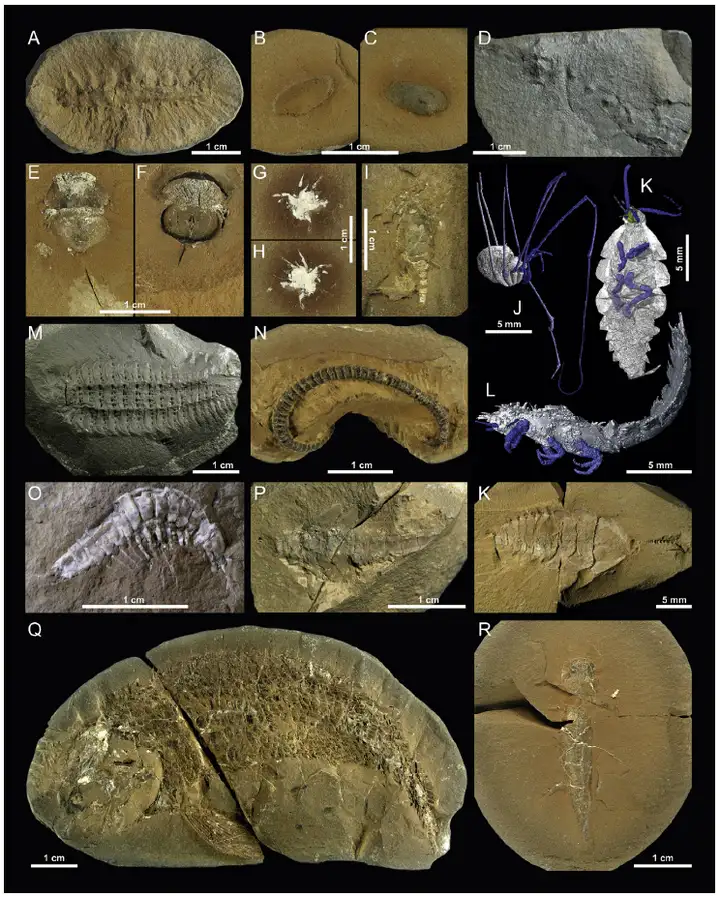

Some of the animal and plant specimens from the Moncafrère peculiar buried fossil assemblage. You can find the small horseshoe crab Alanops magnificus.
Earth Business Card
Fossil location: Montceau-les-Mines Lagerstätte
Geological age : Late Carboniferous (about 300 million years ago)
Location: Massif Central, France, bordering the Bimopise Valley and the Course Valley
Fossil types: freshwater and terrestrial plants and animals (more than 120,000 exquisite fossil specimens)
Sedimentation conditions: freshwater rivers and lakes
Fossil characteristics: Fossils are flattened in sedimentary layers or completely preserved inside siderite nodules. The reserves and types are extremely rich, and the soft tissues are well preserved.
Representative species: insects, crustaceans, arachnids, clawed animals, annelids, molluscs, fish, amphibians, vascular plants


In many Hindu households, Hanuman Ji Photo
holds a place of great reverence. Depictions of this revered deity often grace home altars, living rooms, and workspaces. Hanuman Ji, known for his unwavering devotion to Lord Rama and immense strength, symbolizes both protection and divine guidance.